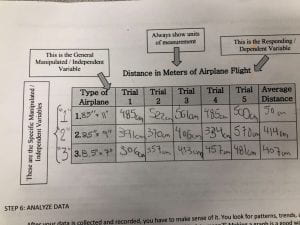Because paper airplanes lack any kind of constant propulsion systems such as the ones of commercial airliners and fighter jets, gliding would be essential for their flying. But just how important is it? This experiment shows how, because there is more area for air under the wings, the plane with the largest wings flew farthest.

The 3 paper airplanes, dubbed “3,” “2,” and “1” respectively from top.

The experiment itself–each time the plane was thrown, written down on a chart.
The experiment showed that the plane that would typically go farthest would be the plane with more area under the wings, with the average for flight length before hitting the floor almost 1 full meter longer than the other 2 aircraft (5.11 m to 414 m and 407 m). While the testing wasn’t that extensive, it did show that bigger wings means better gliding.
What I learned:
I learned, through the experiment and research that came with it, that there isn’t objectively a “best” paper aircraft, thanks to the many things that affect the flight distance of the plane, such it’s weight distribution, the specific type of paper, and the style/way the paper was folded. Even the slightest creases could cut the flight length in half in some situations.
I also learned some basic aerodynamics about wings. Basically, smaller wings produce less lift for the plane, but also less drag. The less drag means the aircraft goes faster, but the less lift means that it can’t carry nearly as much and needs speed to stay airborne, as well as gliding being practically useless. On the opposite side of the spectrum, bigger wings maximize the amount of area for which air gets caught under to create lift, but also drag. However, while the plane goes slower thanks to the drag, the high amount of lift means it can carry much more than it’s speedier counterpart, and is ideal for gliding around.
If I could repeat the experiment, what would I do differently?
If I had to repeat the experiment, I would try to control more of the variables, as some of the outputs were wildly unpredictable. One variable I couldn’t control was the exact area and dimensions of the wings, as the craftsmenship was rushed due to the limited amount of time for the experiment itself.